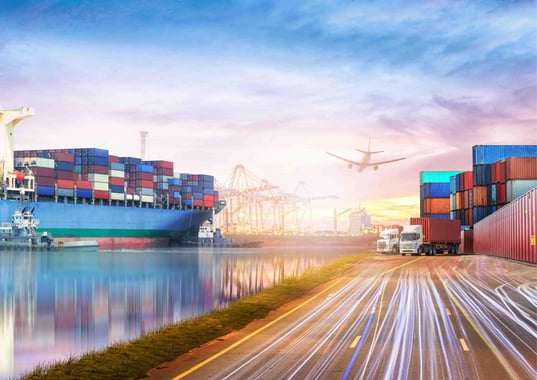How to manage price volatility in freight transport?
The digitalisation of road freight transport has become essential for optimising logistics operations. By adopting digital tools, companies can not only reduce their costs, but also improve their competitiveness and compliance with new regulations.

Freight transport is exposed to high price volatility, affecting air, sea and road freight. Several parameters have an impact on price trends, including transport costs, the economic situation, the political/geopolitical context, and exceptional events such as health crises and climatic events.
How can you gain greater visibility over freight rates and access clear information on price trends with complete transparency? The digitalisation of freight transport and the use of data science now offer tools to improve price forecasts and bring greater transparency to the supply chain.
Monitoring transport costs
Operating costs are one of the most important parameters determining freight transport prices. Here are the main operating costs to keep an eye on, whatever the type of transport:
- Staff salaries. This is a particularly sensitive point in road haulage, firstly because it weighs heavily in the cost price of a truck, and secondly because of the shortage of drivers. The cost of truck drivers is influenced not only by the shortage of manpower, but also by the social policy of each country.
- Fuel. This is an essential component of operating costs, for road hauliers as well as shipping companies and airlines. The volatility of the price of a barrel of oil is therefore a major factor influencing fuel prices. Taxation also plays a significant role: most modes of transport have fuel surcharge or price indexation mechanisms.
- Means of transport : trucks, container ships, aircraft. Transport equipment requires substantial investment. The cost of owning these means of transport and insurance (for both transport equipment and cargo) influence the carrier's operating costs. Optimizing volumetric weight is an important parameter, both for the carrier, who needs to make the means of transport profitable, and for the shipper, who is seeking to reduce transport costs.
Tracking economic conditions
Freight transport is a true barometer of economic conditions. In a liberalized market, the balance between supply and demand has a greater impact on transport prices than operating costs.
Several indicators need to be monitored, for both domestic and international transport:
- Transport supply: when there is overcapacity, freight rates fall. These conditions are favorable for shippers, who can thus reduce their transport costs, but they weigh on the operating accounts of road, sea and air carriers. Conversely, a lack of means of transport increases the cost of transporting goods.
- Demand : transport is highly dependent on the health of the economy and consumption. It is therefore highly sensitive to economic crises (such as the 2008 crisis), but also to cyclical peaks. The sector experiences “peak seasons” at Christmas, for example, which have a major influence on transport prices. The development of e-commerce is multiplying these consumption peaks.
The political and regulatory context
Certain political decisions can have a considerable impact on the evolution of transport costs. In particular, governments act on taxation, which can have an impact on labor costs or be used to steer the energy transition. They may also impose certain obligations, which must be taken into account in the transport contract.
Moreover, over the past 30 years, logistics have become increasingly globalized, boosting international transport. Geopolitics is therefore a decisive factor in the fluidity of the supply chain. State strategies in terms of customs duties, in particular, can have a major impact on the cost of goods. It can influence location/relocation, and thus modify transport flows and the transit of goods. For both imports and exports, shippers need to pay close attention to customs clearance conditions, which are an integral part of an optimized strategy.
Digitization for greater transparency
Today, transport operators can improve their visibility of transport prices and put an end to market opacity thanks to the digitization of freight transport and the use of data science. Collecting and analyzing data can improve price forecasts and bring greater transparency to the supply chain. This can help operators to better anticipate price fluctuations and adjust their strategy accordingly.
Freight price analysis tools exist today. One example is Upply's Smart platform, which benchmarks millions of transport prices (road, sea and air freight). This tool enables both shippers and carriers to better understand market trends. When preparing for tenders, a price benchmarking tool such as Smart saves time and provides a clear view of market prices. Buying transport is a complex, time-consuming process with little automation, so it's important to have market prices in mind to make the best decisions for your business.
The complete solution for your digital transformation: Upply
Upply is the 360° platform that is revolutionizing freight transport management by putting data and technology at the service of operational efficiency.
On the one hand, benchmark and analyze your transport prices by comparing them to the market with the Upply Smart solution, and on the other, join shippers and carriers within a single platform with the Upply Connect solution, which is also integrated with the market's leading TMS. Integrating these new tools into your processes will not only enable you to meet today's challenges, but also prepare your company for future developments in the sector.
Book an appointment with an Upply expert to help you find the solution best suited to your business needs.
Articles that might interest you


Explore the latest market trends with Market Insights
- In-depth studies on freight transport, supply chain and international trade
- White papers and regular reports for constant strategic intelligence
- Analyses by our recognized industry experts


